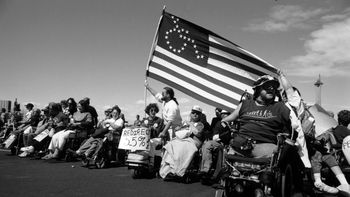Disabled people have suffered a history of abuse and dehumanization at the hands of the US government and the world. Disability has long been both stigmatized and sensationalized, from the freak shows of the late nineteenth and early twentieth centuries to the unwilling institutionalization and sterilizations of disabled people. After WWI, newly-disabled veterans forced the US government to provide them accommodations in exchange for their service to the country. This push for the reconceptualization of what “disabled” means, along with the election of America’s first disabled president, Franklin Delano Roosevelt, brought awareness to the institutionalized discrimination of disabled people, but nothing meaningful was done. Equity issues began to mount when disabled people could not access places of work or were not hired because of their ability status. These issues only intensified after WWII, when many soldiers came home facing new lives with disabilities. This current of discontent strengthened into the 1960s.
The disability rights movement began gaining momentum in the 1960s, feeding off of the revolutionary energy of the civil rights Movement. ADAPT called its fight for accessibility “Our Selma”, and it is through collaborations with the civil rights movement that ADAPT began and remains highly intersectional. Disability rights groups sought legislation prohibiting discrimination based on ability status following the 1964 passage of the Civil Rights Act. Eventually, disabled people and disabled allies came together to advocate the passing of the 1973 Rehabilitation Act, which granted disabled people some civil liberties and protection from discrimination. Disability rights groups lobbied for the passing of the Americans with Disabilities Act (ADA) that mandated accessibility accommodations and prohibited the discrimination of disabled people. Following the passing of the ADA, many disability rights groups have focused on its implementation, ensuring that businesses and the government are following the law. Groups also continue to focus on eroding the institutional and social stigma against disabled people, as discrimination still persists, as evidenced by people with disabilities having higher rates of unemployment than able-bodied people.
Today, within the disability rights movement, there are lingering questions- Who is considered disabled? How do we define disability? Is it ethical to treat a disability as something to be “fixed”? Should allies be allowed to identify as disabled? There are also emerging questions, especially with the advent of new technology. For example, should people choose to abort fetuses with disabilities? Could a person choose not to “fix” their disability even if a cure was available? As time progresses, our notions of "cure" and "health" will also change, and the disability rights movement should be organic to adjust to these changes.

